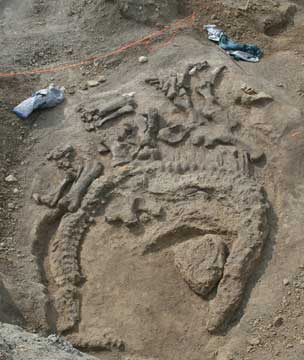|
NEWS NOTES
Paleontology
A huge discovery in Wyoming
 Marilyn Keane |
In June, a geologist and a band of weary volunteers digging on private land in Wyoming discovered a spectacular skeleton of a 150-million-year-old Camarasaurus. The skeleton is more than 90 percent complete and is highly articulated — with all of its bones still connected as they were in life — making it quite a rare discovery even in a region known for its dinosaur finds, Bob Simon, the geologist leading the excavation, told the Billings Gazette July 10.
Camarasaurus was a giant four-legged sauropod that lived in North America during the Late Jurassic period from 155 million to 145 million years ago. This skeleton indicates that the dinosaur weighed roughly 15 tons and was 18 meters long. The team has managed to expose most of the fossil within a month, with only a section of its tail remaining buried. It will likely remain buried until the team can excavate a fossil of another sauropod — a diplodocus — that lies on top of the tail, Simon said.

 Subscribe
Subscribe


